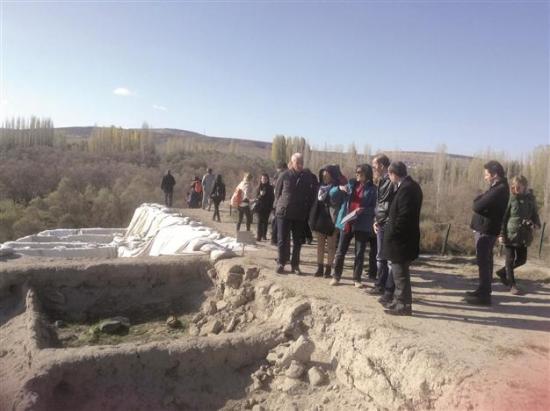Barçın Yinanç
Source - http://www.hurriyetdailynews.com/cappadocias-11000-year-old-settlement-thrills-experts--.aspx?pageID=238&nID=74152&NewsCatID=375
After 25 years of excavations, Aşıklı Höyük continues to thrill archaeologists, who believe the number of things left to discover at the site would allow for at least another 25 years of work or more

Professor Mihriban Özbaşaran from İstanbul University, the current head of the excavation and research project at Aşıklı Höyük, was a doctorate student when excavations at the site in the Cappadocia region of Central Anatolia began in 1989.
Her enthusiasm about Aşıklı Höyük appears to still be very strong, even after 25 years at the site, as the pleasure she takes from accompanying and briefing a group of journalists is very discernible. She hopes their visit will shine a spotlight on Aşıklı Höyük, which has been overshadowed by the popularity of archaeological sites such as Göbeklitepe and Çatalhöyük. Yet with its inhabited history dating back to 9000 B.C., Aşıklı Höyük is 1,000 years older than the Çatalhöyük settlement on the Konya plain and as the earliest village settlement founded in the Cappadocia region, the site is no less important.
Excavation studies undertaken at the site have yielded crucial conclusions about the history of the region. Aşıklı Höyük’s importance stems from findings that shed further light on the transition by humans in the region from a nomadic to a sedentary lifestyle, according to Özbaşaran.
Nomadic communities, who survived by consuming what was available in nature by hunting and gathering, began to settle down in permanent villages and produce their own goods. “Before, they were in small groups on the move. Here is the first time they started to be together for 24 hours as a community,” she said.

In Turkey, Southeast Anatolia is where the first developments related to this transition took place. “What excites me the most about the site is that before the excavation studies started at Aşıklı it was thought that these developments have diffused from East to West,” Özbaşaran said.
Studies at Aşıklı show that this lifestyle transition happened independently in the Central Anatolia region, and developments specific to local communities, such as animal domestication and construction technologies, occurred as a result of interaction with neighboring communities, she added.
The site welcomes visitors with replica houses. They are one-to-one scale replicas of their originals in terms of size, direction and plan. In terms of history of architecture, Aşıklı Höyük provides the earliest examples of the traditional mud-brick architecture of Anatolia and how these structures developed through time can be traced. The first inhabitants of Aşıklı built semi-subterranean oval-shaped huts.
Over time these huts were replaced by rectangular-shaped mud-brick buildings, and people began to live in clusters of buildings adjacent to each other, forming different neighborhoods. Streets separating the buildings are observable to visitors, as the site is designed as an open air museum or archaeological park.
Some 80 skeletons including a fetus were found during the excavations, suggesting that the mortality rate of children was high. The male population had individuals that lived up to the age of 50, while females died between the ages of 30-35.

“Looking at the way they lived and burial rituals, we could not find any sign that would suggest the presence of a hierarchy in the community. We can’t discern a ruling class for instance,” said Özbaşaran.
There are two distinct areas at the site. The northern section comprises a residential area with rectangular mud-brick buildings, while the area to the south contains two special function buildings.
Analytical results have concluded these buildings were communal spaces related to the social life and ritual beliefs of the Aşıklı community, and were used during celebrations and feasts. Visitors can take a closer look at the remains of these buildings, which are now under a protective roof shelter.
Aşıklı Höyük harbors many firsts. It is the first settlement on the Central Anatolian Plateau where copper was mined. It was also the site where the earliest-known brain surgery and first autopsy were performed, as the skulls of two individuals recovered from the site provide crucial information about the history of medicine.